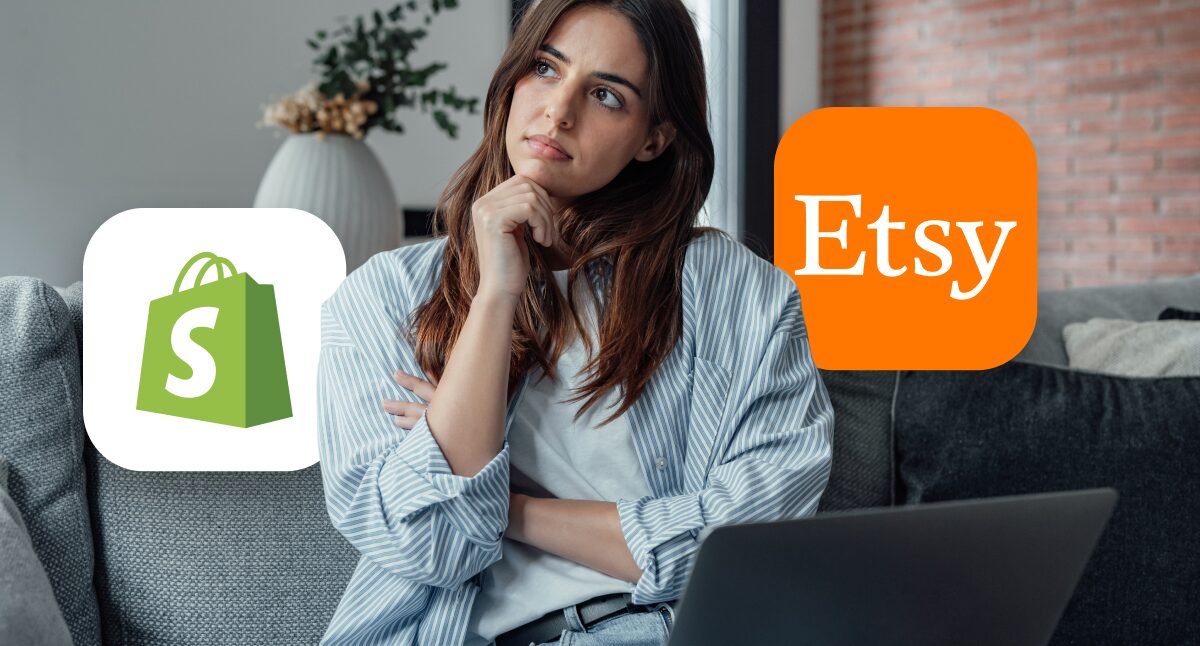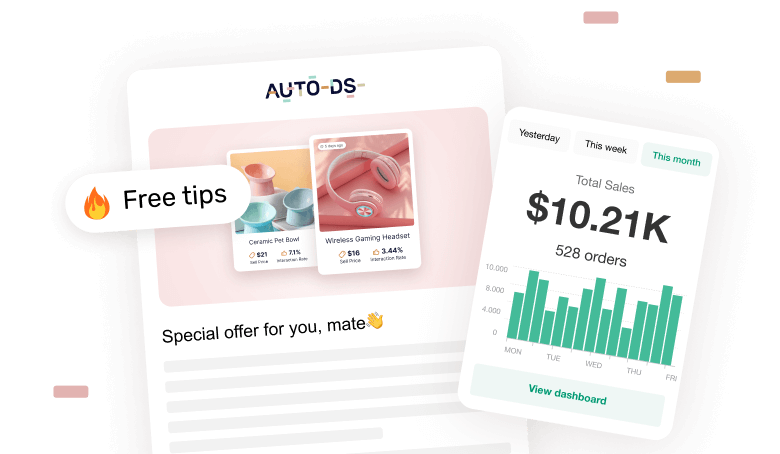One of the most crucial decisions every dropshipper faces at the start of their journey is choosing which platform (or platforms) to use. Whether you’re looking for where to build your online store or deciding where to source your products, you’ll notice plenty of similarities across sites, but also some key differences.
The closer a platform’s policies fit your brand identity, the closer you’ll be to success.
Let’s clarify: this Shopify vs. Etsy isn’t a boxing match. The goal isn’t to crown a winner or loser but to help you figure out which platform makes the most sense for you and your business model. With this information, making that big decision will be a breeze.
Plus, we’ll dig into how AutoDS simplifies dropshipping on both Shopify and Etsy through automated solutions, making your e-commerce life much easier and maybe even a bit more fun.
Etsy is ideal for unique handmade and vintage crafts.
Shopify offers unlimited customization and branding.
AutoDS automates dropshipping across both platforms.
Etsy has a ready-made audience with easy setup.
Shopify supports scalable growth and multi-channel sales.
Shopify VS Etsy: Key Differences at a Glance
Features | Shopify | Etsy |
Platform type | Customizable e-commerce store | Online marketplace |
Customization | Extensive: themes, apps, branding | Limited: shop, banner/profile only |
Audience | Self-built | Built-in, niche focused |
Product types | Any: retail, POD, drosphipping, digital | Handmade, vintage, craft supplies |
Fees | Monthly subscription + transaction | Listing and transaction fees per sale |
Best for | Brand builders, scaling businesses | Creatives, crafters, product testers |
Some comparisons just feel unfair. Who do you love more—your mom or your dad? Are you a Stones or Beatles person? When it comes to Shopify and Etsy, we’re not exactly talking apples to apples; think more like apples to oranges. Both are fruit, sure, but the taste and texture are worlds apart.
Here’s a quick snapshot so you can see what’s really going on with each one.
To start, it’s key to point out a difference that will help you understand things as a dropshipper: when you launch your online store, you’ll usually choose between customizable e-commerce stores or marketplaces. Both options have their benefits and drawbacks; each is handy for different goals.
Shopify: Build Your Own Dream Store
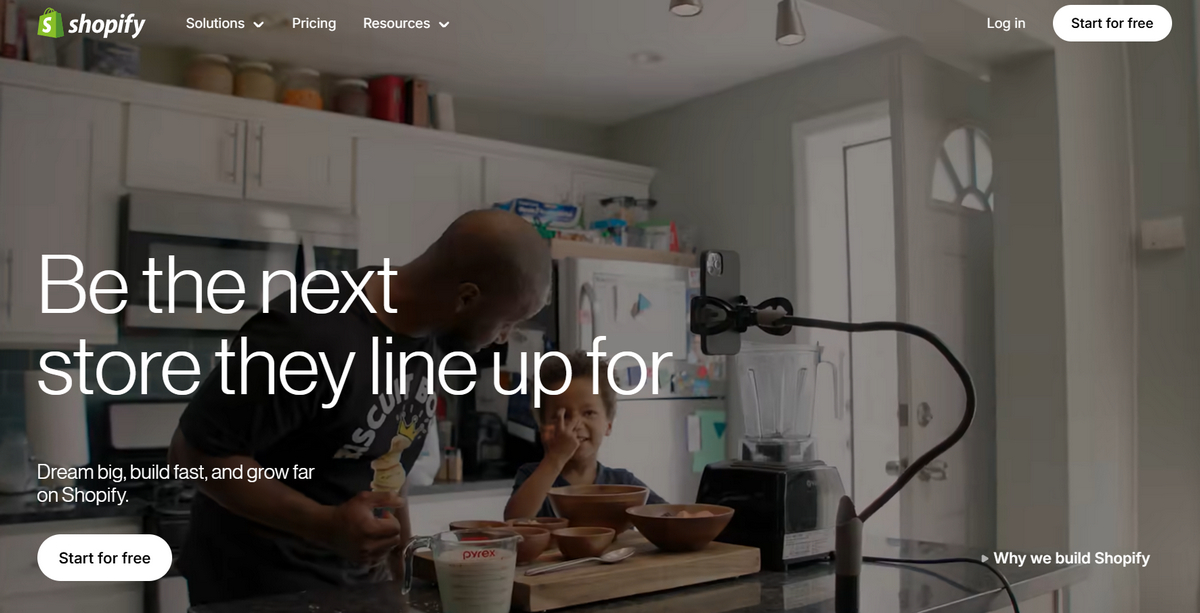
Shopify is the classic customizable e-commerce store. Picture building your house from the ground up, all the way from laying the foundation to picking out the wallpaper and filling the corners with your favorite plants. In practice, this means:
- Total Freedom of Brand and Design: If you want every last pixel under control, dropshipping on Shopify lets you shape your store to be the spitting image of your brand. It’s a blank canvas for building a unique identity.
- Limitless Scalability: Dreaming big? Shopify is made to grow with you. Add thousands of products, bolt on advanced marketing tools, and expand to new sales channels as easily as changing the channel on your TV.
- Endless App Store: Think of it as a giant toolbox. Need email marketing, SEO, inventory management, or maybe a little checkout magic? There’s probably an app for that. Shopify offers thousands of free and paid apps so your store can do whatever you need.
Of course, back to that house metaphor: building something amazing takes time. When you choose a customizable e-commerce store, you’re also taking on the challenge of growing your audience customer by customer, with a bit of marketing wizardry (and some automation, too).
🆕 Beginner’s Tip: If this is like building a house, then AutoDS is your own Extreme Makeover team. Remember that show? Build your store in minutes with the AutoDS AI Store Builder!
Etsy: Step Into the Busy Marketplace
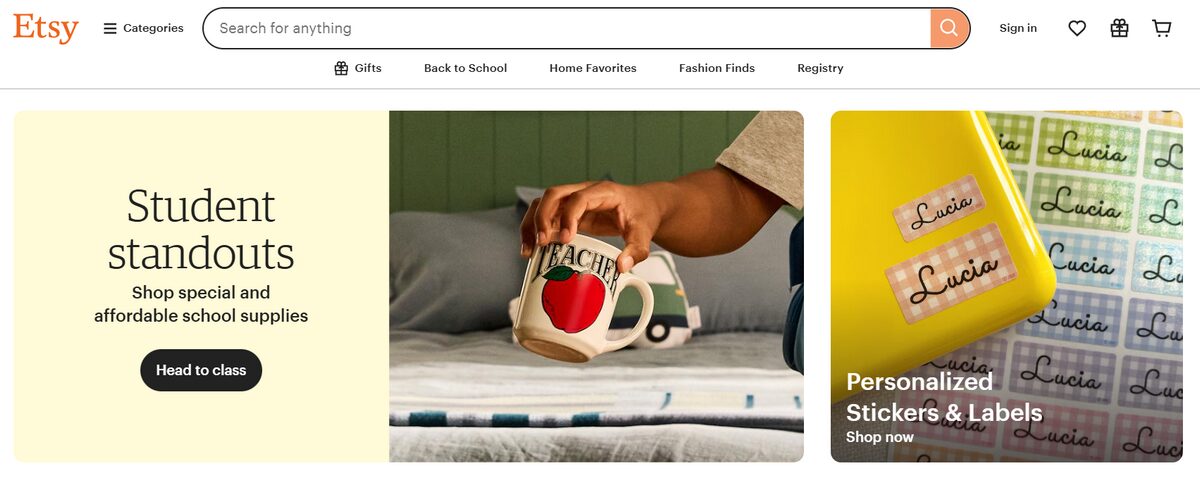
On the other hand, we have marketplaces, right? But Etsy isn’t just any marketplace. Dropshipping on Etsy is like setting up your own booth in a super-busy craft fair. They already have a built-in audience; thousands of shoppers trust the platform, and you benefit from day one.
For Etsy, in particular, the crowd is hunting for something special and genuine. To get a feel for Etsy, just look at what it offers:
- Ready and Waiting Audience: Millions visit Etsy specifically for handmade, vintage, or unique items. Your job? Upload your products, and you will have eyeballs on them right from the start.
- Quick and Simple Setup: Want to start selling now? With Etsy, you can open a shop and list products in minutes. It’s ideal if tech isn’t your thing or you’re in a hurry.
- A Home for the Authentic: If your thing is art, crafts, vintage goods, or custom items, Etsy is your natural habitat. The platform is built for this niche.
In short, every platform has its own “superpower.” The trick is figuring out which matches your business vision best. Next, we’ll dive right in so you can see in detail what each platform truly offers.
Platform-by-Platform Deep Dive: Shopify Or Etsy?

This Shopify vs. Etsy comparison needs to be as detailed as possible; only with a deep understanding will you be able to choose wisely. Now that we have an overview, let’s review both platforms point by point. As we’ve seen, their main difference lies in that one is a customizable e-commerce platform and the other a marketplace, but let’s dive a bit deeper into the details.
Shopify:
1. Setup & Onboarding
Getting started with Shopify is straightforward. The registration process guides you through choosing a plan, picking your store name, and launching with just an email. You can have your store created and your first product listed in under an hour, especially with the help of tools like the AutoDS AI Store Builder for near-instant setup.
Some technical know-how is helpful, but Shopify’s interface is designed for non-coders. Dozens of professional themes give you nearly unlimited creative freedom. You may fully customize your storefront or dive into the code. A custom domain is as simple as a few clicks, empowering you to own your brand from the start.
2. Branding & Store Control
As we saw above, Shopify is all about letting you build your brand, your way. You get a custom domain, complete visual control (logos, layout, colors, navigation), and the freedom to craft a unique customer journey. Want splashy landing pages, an embedded blog, or multi-step funnels? You’re in luck—these are native or easily added with apps. From your favicon to your checkout experience, Shopify hands you the keys.
3. Product Sourcing & Listings
Shopify allows you to list just about anything: physical products, print-on-demand (POD), dropshipped goods, digital downloads, or even subscriptions. Dropshipping? No problem, unlike other known platforms, Shopify is dropshipper-friendly and supports major automation tools such as AutoDS.
Listing products can be as simple or detailed as you want, with options for bulk uploads, multiple variants, and strong SEO editing. Advanced SEO tools help see each product, while integration with fulfillment services removes much of the manual heavy lifting.
4. Customer Base & Traffic
Unlike marketplaces that provide built-in traffic, Shopify requires you to build your own audience from scratch. Your customer base is completely yours (no platform competition), but constructing a steady flow of traffic takes ongoing marketing, content, and SEO work.
The flip side: you have total visibility into your audience’s behavior, demographics, and repeat-buying habits. Multi-channel sales and advanced analytics give you everything you need to grow.
5. Marketing & Sales Tools
Shopify excels in marketing automation. Its built-in tools for email marketing, abandoned cart recovery, and discount codes are just the start. Integration with Facebook, Instagram, TikTok, and other marketplaces expands your reach.
The Shopify App Store offers thousands of marketing tools for every need, plus advanced analytics and seamless advertising integration via Meta, Google, and more.
Are you terrified by the challenge of being creative in marketing your products on Shopify? Test the AI Product Title & Descriptions Generator and save time with a 14-day trial for just $1!
6. Order Management & Fulfillment
Order fulfillment can be done manually or automated. Shopify integrates with major dropshipping and POD suppliers, streamlining inventory, tracking, cancellations, and returns.
Real-time inventory syncing from Shopify and Etsy helps keep stock levels accurate. Order tracking for both you and your customers is included, and automated notifications keep everyone in the loop.
💡 Pro Tip: Many dropshippers are already making a difference by adding a POD model to their dropshipping. Why not give it a try? Check out the AutoDS POD feature and make everything much easier.
7. App & Integration Ecosystem
Shopify’s App Store is legendary, thousands of apps covering everything from automation and email marketing to accounting, shipping, and CRM. Tools like AutoDS or Dsers automate sourcing and order fulfillment, while print-on-demand support is deeply integrated.
Need to sell across channels? Shopify connects to Amazon, eBay, Walmart, and beyond with just a few clicks.
8. Fees & Cost Structure
You’ll pay a monthly subscription (starting at $29), plus transaction and payment processing fees that scale with your plan. Costs are fairly predictable, though stacking up premium apps can add up. You don’t pay per listing. Margin control is in your hands, but advertising and app costs should be carefully managed as you grow.
9. Scalability & Growth Potential
Scaling on Shopify is virtually limitless. The infrastructure handles high product and sales volumes, plus team collaboration features and advanced reporting. Growing internationally is as simple as adding language and currency support, and Shopify’s hosting is robust enough for traffic spikes. Whether you’re selling 10 items or 100,000, Shopify is built for growth.
10. Customer Support & Community
Shopify offers 24/7 support via chat, email, and phone. Its extensive help docs and seller community are active and supportive. There’s a huge ecosystem of developers and designers available for hire, and peer forums are packed with practical wisdom.
11. Policy & Risk Management
Shopify is flexible and permissive for most legal product types. You must comply with global and local dropshipping regulations, but product categories are generally open (excluding a few restricted items). Store suspensions and disputes are rare if you stick to clear guidelines, and there’s a transparent resolution process for issues that arise.
Etsy
1. Setup & Onboarding
Etsy’s store setup is famously fast and simple. Signing up only takes a few minutes, and you can have your first handmade, vintage, or craft product listed even faster. Minimal technical skill is required.
Etsy walks you through each step and provides easy templates for storefront visuals. However, design customization is limited: your shop banner and profile image set the tone, but you’re working within Etsy’s marketplace framework.
2. Branding & Store Control
Branding on Etsy is all about personality, but within limits. You can upload a shop logo and banners, write your “About” section, and style product photography to match your vibe.
However, the core look and structure are consistent across all stores: navigation, layout, and color schemes are not yours to change. You don’t have control over landing pages, blogs, or unique customer funnels. The experience is distinctly “Etsy,” not an independent store.
3. Product Sourcing & Listings
This platform is niche-specific: you may sell handmade goods, vintage items (20+ years old), and craft supplies. Print-on-demand and digital downloads are allowed if they fit these guidelines. Mass-produced or generic goods are not welcome.
You can dropship only if the products are original designs and comply with Etsy’s policies. Listing each item involves filling out detailed forms and uploading images, but bulk import is not a native feature. SEO fields exist for titles, tags, and descriptions, helping products surface in search.
4. Customer Base & Traffic
Etsy’s major draw is its built-in audience: millions of buyers actively search for unique products, ready to discover your creations. You benefit from Etsy’s marketplace traffic and established SEO presence: most sellers see organic visits from day one.
Buyer demographics are skewed toward arts/crafts, personalized gifts, and vintage enthusiasts. Repeat purchase behavior is high for standout brands, but ultimately, shoppers remain loyal to Etsy, not individual stores. Marketplace competition is significant.
5. Marketing & Sales Tools
This marketplace offers simple but effective marketing: built-in email campaigns, abandoned cart emails, and easy coupon code generation. Listing promotion is handled via Etsy Ads, boosting your products within the marketplace search. Social media integrations exist, but are limited compared to Shopify. Access to advanced third-party tools is much narrower. Analytics and shop performance metrics are available in your seller dashboard.
6. Order Management & Fulfillment
Fulfillment is typically manual: you process, package, and ship each order, though integrations exist with some print-on-demand services. Inventory tracking is handled within Etsy, but bulk management tools are limited.
Order status updates and notifications are built in, making customer communication easy. Cancellations and returns are managed through marketplace tools, with Etsy policies guiding the process.
💡 Pro Tip: Remember: order fulfillment is one of those tasks that, when done manually, consumes valuable time you could use for other priority aspects of your business. With features like Fulfilled By AutoDS, your orders are covered from the moment the customer adds the product to their cart until they receive it.
7. App & Integration Ecosystem
Etsy’s integration options are narrower than Shopify’s. There’s no traditional “app store,” but you can connect with select external tools like AutoDS. Print-on-demand is possible via partner apps but may require third-party solutions. Multi-channel selling is limited, and direct integration with external marketplaces is not native. CRM and accounting tools are basic but functional for small shops.
8. Fees & Cost Structure
Etsy’s fee structure is a pay-as-you-go model. No monthly subscription (unless you join Etsy Plus), but you pay $0.20 per listing, a 6.5% transaction fee, and payment processing fees (usually 3% + $0.25).
Listing renewals and offsite ad fees can chip away at margins, so it’s vital to track your overall costs as you scale. Profit margins can be thinner compared to Shopify, especially with off-site ad participation.
9. Scalability & Growth Potential
This dropshipping platform is perfect for starting out, but it has scalability limits. Managing hundreds of listings becomes tricky due to manual processes and limited shop admin tools. If traffic spikes, you won’t need to worry about hosting, but order fulfillment and messaging can get overwhelming for solo sellers. International expansion is easy through Etsy’s marketplace, but true business scaling often inspires serious sellers to migrate to their site.
Do I have to repeat myself? All of this is way easier with automation.
10. Customer Support & Community
The seller community of Etsy is vibrant, and forums are full of tips and peer advice. There’s strong support for creative and crafty entrepreneurs, and plenty of guides and learn-from-experience resources for newcomers.
11. Policy & Risk Management
Dropshipping on Etsy is legit, but the platform upholds strict policies about what can be sold (handmade, vintage, and craft categories only), and sellers must comply closely. Intellectual property is a big deal—copyright issues, “handmade” authenticity, and category restrictions are closely watched.
Accounts may be suspended or deactivated more frequently for policy violations than on Shopify. Dispute resolution is handled within Etsy’s systems, with buyer protection programs built in.
With these 11 points for each platform, you can analyze all the aspects you need to know to make your final Shopify vs. Etsy decision. I’m not here to rush or sway you—take your time choosing!
AutoDS: Automating Dropshipping on Shopify VS on Etsy
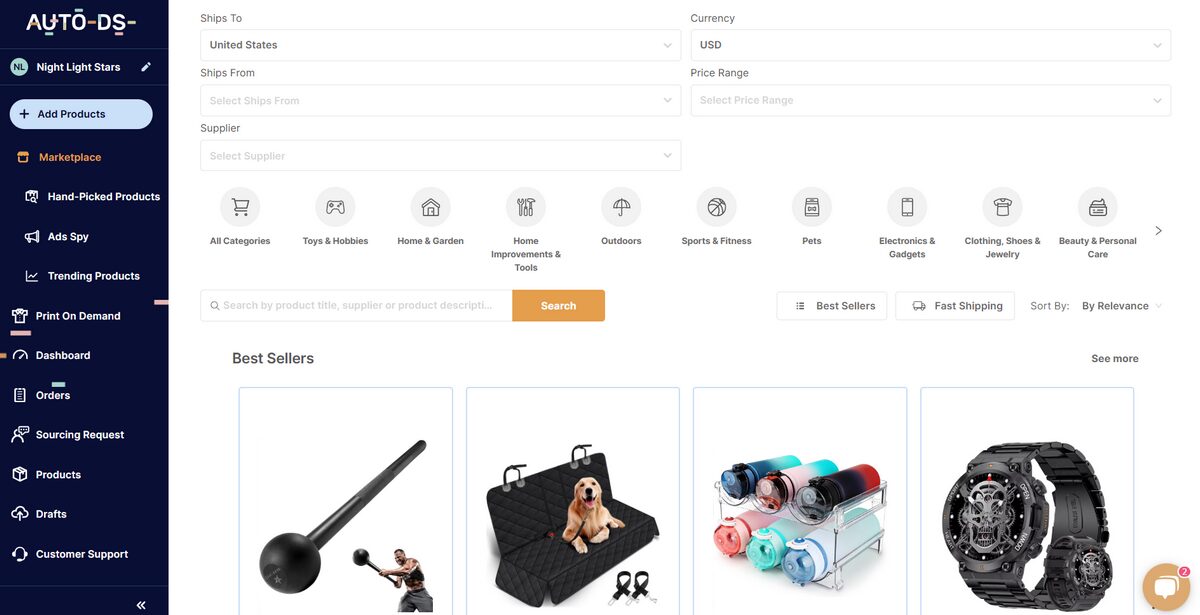
And now, my dear apprentice, it’s time to leave you with a golden lesson: never underestimate the transformative power of automation.
Where you once found pressure, common mistakes, unhappy customers, and that overwhelming feeling of never being able to do it all, you could instead enjoy free time, greater efficiency, scalable growth—and above all, peace of mind—simply by starting to use AutoDS.
So, how does automation impact Shopify and Etsy? Does it work the same way for both? Let’s dig a little deeper.
Automation with AutoDS on Shopify
If you’re dropshipping on Shopify, AutoDS can provide you with a fully automated, end-to-end system, from product sourcing to order fulfillment. As I mentioned earlier, you can set up your store in just two minutes with the AI-powered feature (resulting in a perfectly functional shop that you can later tailor to your taste). And importing products into your ready-to-go store? That’s just one click away with Automatic Product Importing.

What’s more, AutoDS continuously monitors prices and stock levels, automatically updating your listings to prevent overselling and protect your profit margins. When a customer places an order, AutoDS processes it with your supplier instantly, handles payment, and auto-updates tracking numbers as soon as they’re available.
This automation runs 24/7, even when your computer is off, freeing you from manual tasks like copying customer information or logging into supplier sites.
With the AutoDS AI-Built Shopify Store feature, you can create a fully-loaded, branded store tailored to your niche, products, layout, and all in just a few minutes.
Automation with AutoDS on Etsy
For Etsy sellers, AutoDS brings automation to order fulfillment by connecting your shop to multiple Etsy dropshipping suppliers for instant ordering and synchronized inventory. AutoDS manages price and stock updates for your Etsy listings, reducing errors and preventing stockouts.
Just like on Shopify, the platform places the order with your supplier and updates your shipping info, so your customers always know where their order is, and you don’t have to lift a finger.
Managing Multiple Stores
Managing multiple stores is seamless with AutoDS. Whether you run one store on Shopify and another on Etsy, or you’re juggling several shops across both, you can add all your URLs into the AutoDS system. The unified dashboard allows you to monitor orders, profit, stock, and supplier performance from a single place.
My Advice? No matter who wins in your Shopify vs. Etsy decision, make sure AutoDS is in your toolkit. On both platforms, you get:
- Instant product import with optimized listings
- Real-time price and stock monitoring
- 100% automated order placement and fulfillment
- Automatic tracking updates are sent to your customers
- A centralized dashboard to manage all your stores
With automation, your dropshipping business isn’t just easier—it’s smarter, faster, and far more enjoyable.
Frequently Asked Questions
Can I use both Shopify and Etsy simultaneously?
Yes! Many sellers start on Etsy and expand to Shopify. AutoDS lets you manage both stores easily from one dashboard.
Is dropshipping allowed on Etsy?
Yes, but Etsy requires handmade/original products and clear disclosure of sourcing. AutoDS helps keep you compliant.
Which platform is cheaper to start with?
Etsy has lower upfront costs with no monthly fees. Shopify has a monthly plan but scales better for bigger businesses.
Do I need AutoDS if I want to dropship?
It’s not mandatory, but AutoDS automates sourcing, listing, and order management, saving you time and effort on both platforms.
Shopify VS Etsy: Final Take
It’s time for the final round! Shopify vs. Etsy—who’ll take the glory in this corner of the ring? Here’s my take; then you can form your own.
If your thing is crafts and those niches that value the unique, the quirky, and the handmade, choose Etsy. It’s excellent for testing products and gives you quick, efficient access to that market.
But if you’re building a brand from scratch, looking to scale, and want advanced marketing tools ideal for diversification, Shopify is the right fit for you.
For both platforms, AutoDS will help you sell smarter by bringing everything together in one intuitive dashboard, letting you automate most of your dropshipping tasks. And with that, it’s time to say goodbye, but if you’re still hungry to learn, here are three articles you’ll absolutely love:






